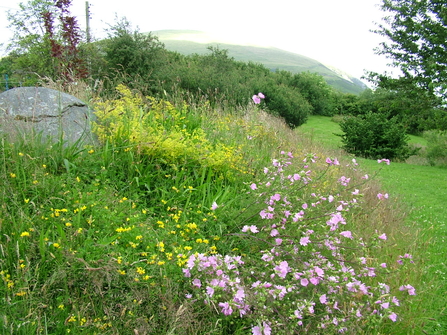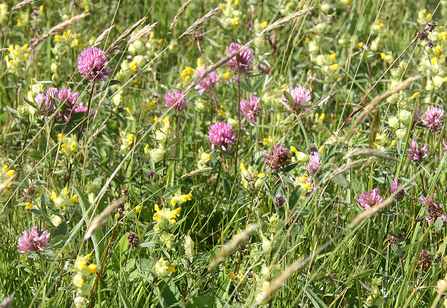Creating a meadow is a fantastic thing to do for wildlife and people. Most of our wildlife will benefit directly or indirectly as a meadow provides food and shelter for insects and invertebrates, which in turn provides food for birds or hedgehogs. You will need to be patient as establishment of wildflowers can be slow so don’t expect too many flowers until the second year (unless you plan on sowing an annual corn flower mix). The reward is worth waiting for though, and perennial meadows usually get better and better with time given the right management.
Create your own meadow or wildflower patch

The success of a perennial wildflower meadow depends on the soil. You may be surprised to learn that they establish best on poorer soils, light subsoils, grits, gravels and limey soils. So the trick is to try and reduce the soil fertility; as a rich, fertile soil encourages strong growth of grasses and weed species which will compete with your wildflowers and win!
It’s always important to note what you already have growing on your patch as you don’t want to destroy good habitat. We would always recommend you wait and see what grows on your patch before converting it.
Preparations
There are two main methods; sowing into bare soil or sowing into an existing sward.
- Sowing into bare soil - Assuming that your piece of land has not already got wildflowers and is simply a grassy lawn, you need to reduce the soil fertility before you sow your seeds. The quickest way to do this is to remove the turf and top few inches of topsoil. Use the turf to make a feature or leave it to break down to make compost. It is essential to get rid of weeds before sowing begins. So, spend some time now removing the roots of weeds such as nettles, docks and thistles. Corn field annuals are happy to grow in richer soils (they used to be common weeds growing in and alongside arable fields).
- Sowing into an existing sward - You can reduce soil fertility over the years by cutting and removing the grass every year. To prepare your area for sowing, we would recommend you cut the grass very short and scarify the turf by raking hard or by other means (tractors etc) to create bare areas of soil/soil scrapes for the seeds to go. The seeds need to get into contact with the soil in order to germinate. It doesn’t work spreading flower seeds on an established sward of grass without serious preparations exposing at least 60% of soil.
Choice of seed mixes
The flowers you can grow will depend on where you live. You will have to choose flowers to suit the site and the soil (sunny/shady, wet/dry, acid/calcareous). Have a look around to see what grows locally and take advice from seed companies specialising in native flowers. The more local the better and don’t buy seeds from abroad.

Perennial meadow flowers that are suitable for many soils are: Bird’s foot trefoil, common knapweed, yellow rattle, field scabious, meadow buttercup, lady’s bedstraw, ribwort plantain, meadow cranesbill, vetches, yarrow, wild carrot, selfheal, ox-eye daisy, betony, red campion, St John’s wort, cowslip, primrose.
Your mix will probably include a range of wild grasses, such as bents, fescues and crested dogstail. Make sure they are not lawn grasses.
Sowing
This is the easy (and fun!) bit, for which you'll need about 5g of seed per square metre. It’s a good idea to mix seeds with light coloured, dry sand (not building sand) to make it easier to see where you have been. Just sow evenly by walking over the site. There is no need to rake the seeds in and you mustn’t cover them with soil. Simply walk gently over the site (or roll it) to make sure the seeds are in good contact with the soil. Most wildflower seeds germinate better when exposed to light. Keep it well watered until established.
Maintenance
The first year only requires light cutting on a high setting around mid summer. You are not looking for a display of flowers this year; it’s the year of establishment. From year 2 onwards you need to cut and remove the hay every year. There are 2 main options for the timing of your cutting. If you have a mainly spring flowering meadow, delay the cut until mid/late summer. If you want a summer flowering meadow you can cut until late March/early April and then again in August/September when the flowers have shed their seeds. Once cut, it’s a good idea to leave the cuttings to dry and drop their seeds for a few days and then it’s essential that you remove the hay Maybe it can be used for animals or compost it. It’s also important to keep on top of weeds such as docks, nettles and thistles by hand weeding.
(There is an increased interest in scything to cut our meadows - so keep an eye on our 'Events' page for courses organised by the Trust if that would interest you).
Wildflower plug plants
If you only have a small area of grass where you want to introduce wildflowers, another option is to buy plug plants. This is more expensive but is usually a safer bet when it comes to establishing wildflowers; you will need about 5-9 plants per square metre. You also need to remove the grass around the plants and, better still, scarify the whole area so the grasses won’t swamp the flowers.
There are a huge variety of plug plants available on-line so try and find a supplier that provides native stock. Plug plants could also work well in wet areas, planting species such as yellow iris, ragged robin and purple loosestrife.
Dont's
- Don't sow seeds into an existing area of grass or weeds without scarifying it first
- Don't sow wildflower seeds in heavy shade such as below conifers
- Don't cover the seeds
- Don't use imported seed
One of my favourite areas in our garden is a wildflower bank which has taken a few years to look as stunning as it did this year; with cowslips, lady’s mantle, musk mallows, bird’s foot trefoil, scabious, yellow rattle, meadow buttercups, red clover, ox-eye daisies - all mixed up in nature’s own beautiful casual design.

